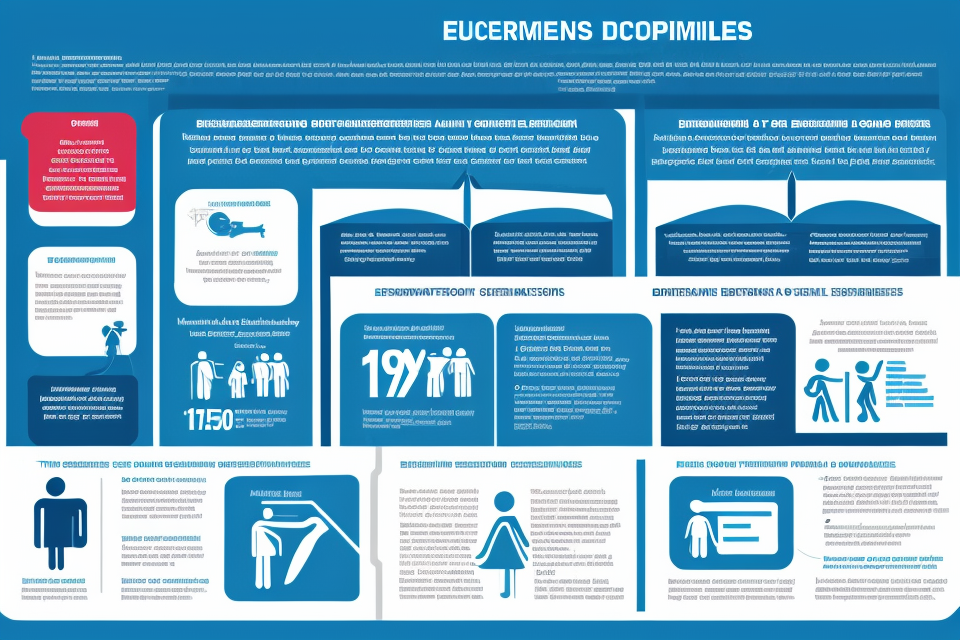
Definition of Federal Government Regulations
Federal government regulations refer to the rules and standards that are established by the federal government to govern various aspects of society, including the economy, environment, and public safety. These regulations are created through a process of legislation and administrative rule-making, and are designed to ensure that certain goals and objectives are met.
Federal regulations in the United States have a long history, dating back to the early days of the country’s formation. The Constitution itself contains provisions that allow for the creation of federal regulations, such as the Commerce Clause, which gives Congress the power to regulate trade and commerce between states. Over time, the federal government has expanded its role in regulating various aspects of society, in response to changing social, economic, and political conditions.
Today, federal government regulations touch on a wide range of issues, from health and safety standards in the workplace, to environmental protections, to financial regulations, and much more. These regulations are designed to promote the public welfare, protect the rights of individuals and communities, and ensure that the country operates in a fair and just manner.
In terms of their impact on department regulations, federal government regulations serve as a framework for the policies and procedures that are implemented by various government agencies. Departments may create their own regulations that are more specific and detailed than federal regulations, but they must also comply with the standards and requirements set forth by the federal government. This can create a complex regulatory environment, with multiple layers of rules and standards that must be navigated by individuals and businesses alike.
Types of Federal Government Regulations
There are three main types of federal government regulations: administrative regulations, legislative regulations, and judicial regulations. Each type serves a specific purpose and is created through a different process.
- Administrative regulations are created by executive branch agencies, such as the Department of Health and Human Services or the Environmental Protection Agency. These agencies have the authority to create rules and regulations that implement and enforce laws passed by Congress. Administrative regulations are often used to provide more detailed guidance on how to comply with a particular law or policy.
- Legislative regulations are created by Congress through the process of passing a bill into law. These regulations are often used to provide more specific guidance on how to comply with a particular law or policy. For example, the Affordable Care Act (ACA) created a number of legislative regulations that healthcare providers must follow in order to comply with the law.
- Judicial regulations are created by the courts through the process of interpreting and applying the law. These regulations are often used to provide guidance on how to interpret and apply a particular law or policy. For example, a court may issue a ruling that clarifies how a particular law should be interpreted or applied in a particular context.
Overall, these three types of federal government regulations play a critical role in shaping the operations and activities of various departments and agencies. By providing clear guidance and standards, these regulations help to ensure that government activities are carried out in a consistent and effective manner.
Importance of Federal Government Regulations
Federal government regulations play a crucial role in ensuring the safety and welfare of the public. These regulations are put in place to protect consumers, workers, and the environment from harm. They are also designed to promote fair competition and prevent fraud.
One of the main reasons why federal government regulations are important is that they help to balance economic growth with the protection of the environment. Without regulations, businesses may engage in practices that are harmful to the environment or to public health in order to increase profits. For example, a company may choose to dump hazardous waste into a river or release toxic chemicals into the air if it is not required to follow any regulations.
However, regulations can also have a negative impact on economic growth if they are too burdensome or if they are not well-designed. Overly restrictive regulations can stifle innovation and make it more difficult for businesses to compete. This can lead to slower economic growth and higher unemployment.
Therefore, it is important for federal government regulations to be carefully designed and implemented in a way that balances the need for public safety and environmental protection with the need for economic growth and competitiveness. This requires a careful consideration of the costs and benefits of different regulatory approaches and a commitment to ongoing evaluation and improvement of regulations over time.
Federal government regulations are rules and guidelines set forth by the federal government to regulate various aspects of society, including businesses, industries, and individuals. These regulations are designed to ensure the safety and well-being of citizens, protect the environment, and promote fair competition. They can impact department regulations by providing overarching principles and standards that departments must follow. Understanding federal government regulations is crucial for individuals and businesses to operate within the bounds of the law and avoid penalties. In this article, we will explore the importance of federal government regulations and how they can impact department regulations.
Federal government regulations are laws and policies established by the federal government to regulate various aspects of society, including the economy, environment, and public safety. These regulations can have a significant impact on department regulations, as departments within the federal government are responsible for implementing and enforcing these regulations. For example, the Department of Transportation is responsible for enforcing federal regulations related to transportation safety, while the Environmental Protection Agency is responsible for enforcing regulations related to environmental protection. These department regulations are designed to ensure that federal regulations are being followed and that the goals of the regulations are being achieved. In summary, federal government regulations set the overall guidelines and standards for various industries and sectors, while department regulations provide the specific rules and requirements for those industries and sectors within the federal government’s jurisdiction.
Department Regulations
Overview of Department Regulations
Definition of Department Regulations
Department regulations refer to the rules and policies that are created by federal agencies to carry out their designated responsibilities. These regulations are often developed in response to laws passed by Congress and are used to provide specific guidance and requirements for how federal agencies should operate.
Explanation of how Department Regulations differ from Federal Regulations
While federal regulations are created by federal agencies to implement laws passed by Congress, department regulations are specific to the individual agency and its areas of responsibility. Department regulations are typically more detailed and specific than federal regulations and provide more in-depth guidance on how an agency should carry out its duties. Additionally, department regulations are often more specialized and focused on the unique needs and responsibilities of the individual agency.
How Federal Government Regulations Impact Department Regulations
Influence of federal regulations on department policies and procedures
Federal government regulations have a significant impact on department regulations, particularly in terms of the influence they exert on department policies and procedures. This influence arises from the fact that federal regulations often set minimum standards that state and local departments must adhere to in order to receive funding or maintain compliance with federal laws.
For instance, federal regulations may dictate specific requirements for licensing, training, and certification of employees in certain fields. These requirements then trickle down to state and local departments, which must ensure that their employees meet these standards in order to maintain compliance with federal regulations. This can impact department policies and procedures by requiring additional training or certification programs, or by mandating specific processes for employee evaluation and management.
Compliance with federal regulations by state and local departments
Another way in which federal government regulations impact department regulations is through the requirement for state and local departments to comply with these regulations in order to receive funding or maintain compliance with federal laws. This can lead to a significant amount of overlap between federal and state or local regulations, as departments must ensure that they are meeting both sets of requirements.
In some cases, federal regulations may preempt state or local regulations, meaning that state or local departments must adhere to the more stringent requirements of the federal regulations. This can lead to conflicts between federal and state or local regulations, and can impact department policies and procedures by requiring departments to prioritize compliance with federal regulations over state or local regulations.
Overall, the impact of federal government regulations on department regulations is significant, and can lead to changes in department policies and procedures in order to ensure compliance with federal laws and regulations.
Examples of Department Regulations
Department of Transportation regulations
The Department of Transportation (DOT) is responsible for regulating various modes of transportation in the United States, including aviation, highways, and railroads. The DOT sets regulations to ensure safety, promote efficiency, and protect the environment. Some examples of DOT regulations include:
- Aviation regulations: The Federal Aviation Administration (FAA) is a part of the DOT and is responsible for regulating the aviation industry. The FAA sets regulations for air traffic control, aircraft certification, and pilot licensing. These regulations are designed to ensure the safety of air travel and the operation of aircraft.
- Highway regulations: The National Highway Traffic Safety Administration (NHTSA) is a part of the DOT and is responsible for regulating the highway industry. The NHTSA sets regulations for vehicle safety, fuel economy, and emissions. These regulations are designed to ensure the safety of drivers and passengers on the nation’s highways and to protect the environment.
- Railroad regulations: The Federal Railroad Administration (FRA) is a part of the DOT and is responsible for regulating the railroad industry. The FRA sets regulations for railroad safety, track and equipment standards, and railroad operations. These regulations are designed to ensure the safety of railroad workers and passengers and to protect the environment.
Department of Health and Human Services regulations
The Department of Health and Human Services (HHS) is responsible for regulating various aspects of the healthcare industry in the United States. The HHS sets regulations to ensure the safety and quality of healthcare services, protect patient privacy, and promote public health. Some examples of HHS regulations include:
- Medicare and Medicaid regulations: The Centers for Medicare and Medicaid Services (CMS) is a part of the HHS and is responsible for regulating the Medicare and Medicaid programs. The CMS sets regulations for provider reimbursement, quality of care, and patient rights. These regulations are designed to ensure that Medicare and Medicaid beneficiaries receive high-quality healthcare services.
* **Food and drug regulations:** The Food and Drug Administration (FDA) is a part of the HHS and is responsible for regulating the safety and efficacy of food and drugs. The FDA sets regulations for food safety, drug approval, and medical device regulation. These regulations are designed to ensure the safety of the nation’s food and drug supply and to protect public health. - Public health regulations: The Centers for Disease Control and Prevention (CDC) is a part of the HHS and is responsible for regulating public health. The CDC sets regulations for infectious disease control, vaccination, and environmental health. These regulations are designed to protect public health and prevent the spread of disease.
Importance of Department Regulations
Department regulations are rules and guidelines established by government departments to ensure effective service delivery, protect the rights of individuals and communities, and maintain accountability and transparency. The importance of department regulations can be further explored by examining their role in various aspects of governance.
- Service Delivery: Department regulations play a crucial role in ensuring that government services are delivered effectively and efficiently. These regulations provide a framework for service delivery, including standards for quality, accessibility, and equity. They also help to ensure that government services are delivered in a consistent and coordinated manner across different departments and agencies.
- Protection of Rights: Department regulations serve as a means of protecting the rights of individuals and communities. They establish standards for fairness, accountability, and transparency in government decision-making and service delivery. By setting clear guidelines and standards, department regulations help to prevent abuses of power and ensure that government actions are consistent with the principles of democracy and human rights.
- Accountability and Transparency: Department regulations promote accountability and transparency in government by establishing clear lines of responsibility and oversight. They require government departments to report regularly on their activities and performance, and to make this information publicly available. This helps to ensure that government actions are subject to scrutiny and oversight, and that government officials are held accountable for their actions.
Overall, department regulations are an essential component of good governance. They help to ensure that government services are delivered effectively and efficiently, that the rights of individuals and communities are protected, and that government actions are subject to accountability and transparency. By establishing clear guidelines and standards, department regulations help to promote trust and confidence in government, and to maintain the integrity of the democratic process.
Final Thoughts
- The importance of continued compliance with federal and department regulations cannot be overstated. This includes regularly reviewing and updating policies and procedures to ensure they align with current regulations and best practices.
- Individuals and communities play a crucial role in advocating for effective regulations and holding departments accountable. This can include participating in public comment periods, attending regulatory hearings, and engaging with elected officials to express concerns and provide input.
- Collaboration between federal and department regulators, industry stakeholders, and the public is essential to developing and implementing effective regulations that balance the need for safety and innovation. By working together, we can ensure that regulations are comprehensive, effective, and tailored to the unique needs of each industry.
FAQs
1. What are federal government regulations?
Federal government regulations are rules and laws that are created and enforced by the federal government. These regulations apply to a wide range of industries and activities, and are designed to ensure that certain standards are met and that the public is protected.
2. How do federal government regulations impact department regulations?
Federal government regulations can have a significant impact on department regulations. Departments within the federal government may be required to comply with certain federal regulations, or may be responsible for enforcing them. In some cases, department regulations may be more stringent than federal regulations, but they must still be in compliance with federal laws and regulations.
3. Are all federal government regulations created equally?
No, not all federal government regulations are created equally. Some regulations are created by federal agencies, while others are created by Congress. Regulations created by Congress are generally considered to be more important and have a greater impact on society.
4. How are federal government regulations created?
Federal government regulations are typically created through a process known as rulemaking. This process involves the publication of a proposed rule in the Federal Register, a period of public comment, and finalization of the rule by the relevant federal agency.
5. How can I learn more about federal government regulations?
If you want to learn more about federal government regulations, you can start by visiting the website of the Federal Register, which is the official publication of federal regulations. You can also contact your local federal representative or senator for more information.


